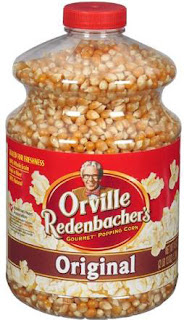Good 41º cloudy morning.
Yesterday, another nice day, and we topped at 78º.
Picture of the Day ... a tiger and lion in love with each other! 
Interesting about popcorn.....
Popcorn (popcorns or pop-corn) is a variety of corn kernel, which expands and puffs up when heated.
A popcorn kernel's strong hull contains the seed's hard, starchy endosperm with 14–20% moisture, which turns to steam as the kernel is heated. Pressure from the steam continues to build until the hull ruptures, allowing the kernel to forcefully expand from 20 to 50 times its original size—and finally, cool.
Some strains of corn (taxonomized as Zea mays) are cultivated specifically as popping corns. The Zea mays variety everta, a special kind of flint corn, is the most common of these.
Corn was first domesticated about 10,000 years ago in what is now Mexico. Archaeologists discovered that people have known about popcorn for thousands of years. In Mexico, for example, remnants of popcorn have been found that date to around 3600 BC.
Popping of the kernels was achieved by hand on the stove-top through the 19th century. Kernels were sold on the East Coast of the United States under names such as Pearls or Nonpareil. The term popped corn first appeared in John Russell Bartlett's 1848 Dictionary of Americanisms. Popcorn is an ingredient in Cracker Jack, and in the early years of the product, it was popped by hand.
Popcorn's accessibility increased rapidly in the 1890s with Charles Cretors' invention of the popcorn maker. Cretors, a Chicago candy store owner, created a number of steam powered machines for roasting nuts, and applied the technology to the corn kernels. By the turn of the century, Cretors had created and deployed street carts equipped with steam powered popcorn makers.
During the Great Depression, popcorn was fairly inexpensive at 5–10 cents a bag and became popular. Thus, while other businesses failed, the popcorn business thrived and became a source of income for many struggling farmers, including the Redenbacher family, namesake of the famous popcorn brand. During World War II, sugar rations diminished candy production, and Americans compensated by eating three times as much popcorn as they had before. The snack was popular at theaters, much to the initial displeasure of many of the theater owners, who thought it distracted from the films. Their minds eventually changed, however, and in 1938 a Midwestern theater owner named Glen W. Dickson installed popcorn machines in the lobbies of his theaters. The venture was a financial success, and the trend soon spread.
In 1970, Orville Redenbacher's namesake brand of popcorn was launched. In 1981, General Mills received the first patent for a microwave popcorn bag, with popcorn consumption seeing a sharp increase by tens of thousands of pounds in the years following.
Air-popped popcorn is naturally high in dietary fiber and antioxidants, low in calories and fat, and free of sugar and sodium. This can make it an attractive snack to people with dietary restrictions on the intake of calories, fat or sodium. For the sake of flavor, however, large amounts of fat, sugar, and sodium are often added to prepared popcorn, which can quickly convert it to a very poor choice for those on restricted diets.
One particularly notorious example of this first came to public attention in the mid-1990s, when the Center for Science in the Public Interest produced a report about "Movie Popcorn", which became the subject of a widespread publicity campaign. The movie theaters surveyed used coconut oil to pop the corn, and then topped it with butter or margarine. "A medium-size buttered popcorn", the report said, "contains more fat than a breakfast of bacon and eggs, a Big Mac and fries, and a steak dinner combined." The practice continues today. For example, according to DietFacts.com, a small popcorn from Regal Cinema Group (the largest theater chain in the United States) still contains 29 g of saturated fat. the equivalent of a full day-and-a-half's reference daily intake
An early popcorn machine in a street cart, invented in the 1880s by Charles Cretors in Chicago.
From Mr. Food
Our Stuffed Pizza Casserole is a great weeknight meal! Kids will love it and so will all the kids-at-heart at your table! It's a double-crusted hearty deep dish pizza chock full of a beef, Italian sausage and veggie filling that will have everyone begging for seconds!
- 1/2 pound Italian sausage, casing removed
- 1/2 pound ground beef
- 1 cup sliced fresh mushrooms
- 1/2 cup chopped red bell pepper
- 2 (10-ounce) cans refrigerated pizza dough, divided
- 3 cups shredded mozzarella cheese, divided
- 1 1/2 cups pizza sauce, divided
- Preheat oven to 425º. Coat a 9- x 13-inch baking dish with cooking spray.
- In a large skillet over medium heat, cook sausage and ground beef 8 to 10 minutes, or until browned, stirring occasionally. Stir in mushrooms and bell pepper and cook 3 to 5 minutes, or until just tender. Drain and set aside.
- Meanwhile, unroll 1 pizza dough, press into bottom and halfway up sides of prepared baking dish. Sprinkle with 1 cup cheese, top with 3/4 cup pizza sauce, spoon meat mixture evenly over sauce, and sprinkle with 1 more cup cheese. Unroll and place second pizza dough on top. Press bottom and top crust edges together to seal. Make a few small slits in top crust.
- Bake 15 minutes. Remove from oven, pour remaining pizza sauce over crust and sprinkle with remaining cheese. Bake an additional 8 to 10 minutes, or until crust is browned.
Historically this date.....
dissolves and Benito Mussolini tries to escape. This day is taken as symbolic of the Liberation of Italy.
And births this date include....
1940 - Al Pacino, American actor
Rode hard? Put away wet? Ewwww......
All I know. Nuff said. Have a good Monday. Ciao.
xo Sue Mom Bobo
National Hug A Plumber Day on April 25th recognizes those who come to our rescue when pipes leak or drains are clogged.
Plumbers have kept the water flowing since ancient Rome. Whether it is a minor leak to a major clog, a plumber will have the right tool for the job. They also help us install the right pipes and plumbing types when building a house or new business. They’re the water specialists – designing plumbing systems that work when we need it. Thanks to plumbers, we have hot water on demand. Showers come with a variety of options and kitchens provide the ultimate convenience.
Consider how plumbers improve our lives and health in the modern world. Their contributions could be inventions the human race would have a difficult time living without. Given a choice between using only a flush toilet or a smartphone for the rest of your life, which would you choose?
From the moment you wake in the morning to every glass, flush and wash, a plumber makes life easier even if you never have to call one.











No comments:
Post a Comment